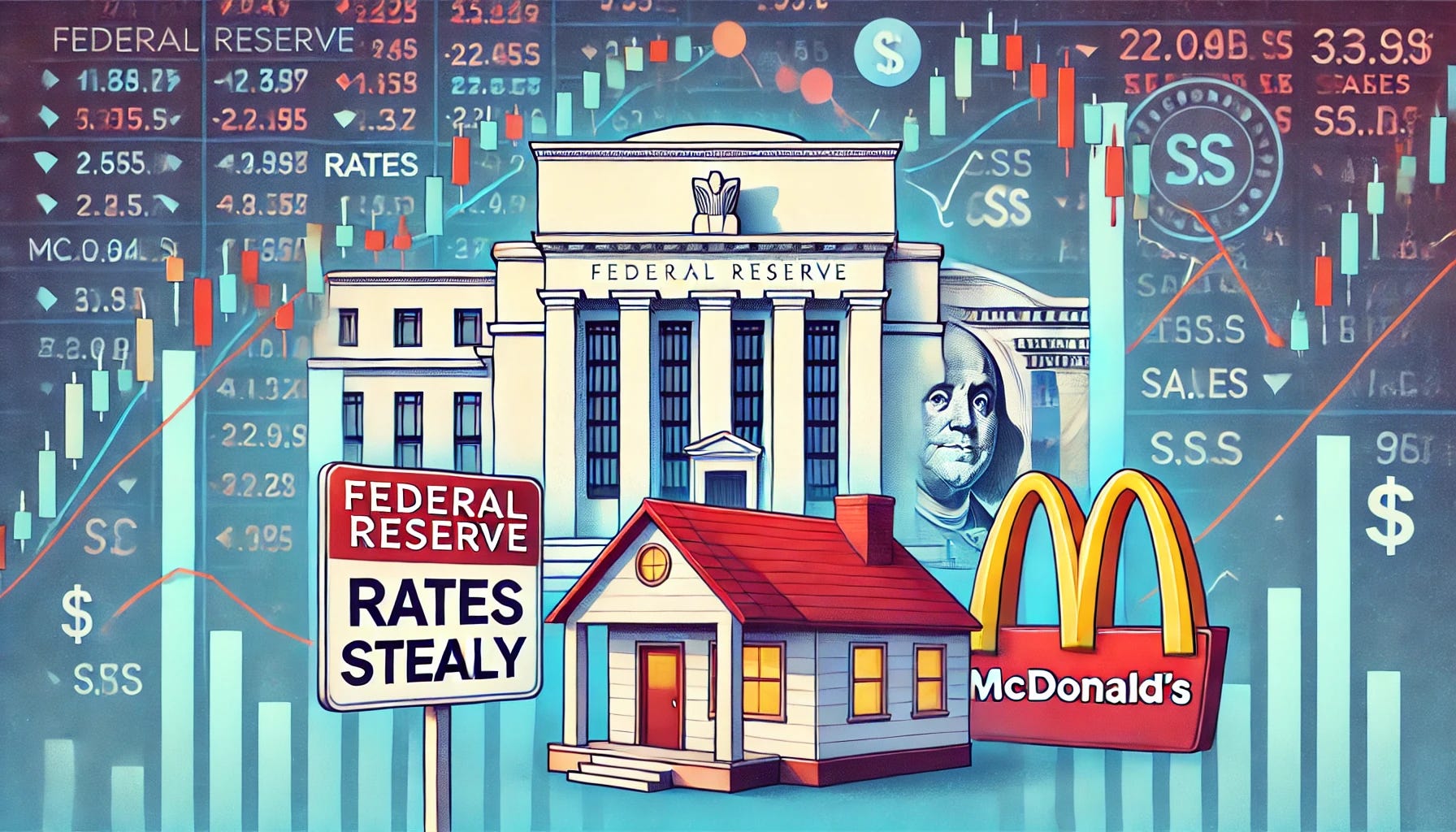The highly anticipated Federal Reserve policy meeting starts today, and markets are already feeling the jitters. Defensive stocks are seeing inflows while small caps and tech stocks face outflows, signaling investor caution ahead of tomorrow's Fed announcement.
On my radar is CrowdStrike (CRWD), which nosedived nearly 12% on Tuesday. The plunge came after Delta Air Lines announced it would seek compensation from the cybersecurity firm for last week's outage.
Last week, I released a special research report for paid subscribers on how to trade CrowdStrike by leveraging elevated risk premiums and market conditions for optimal returns. With this recent move lower, we're looking at an ideal risk/reward opportunity. Check out the report here.
The Federal Reserve seems to be facing the imminent threat of a recession, and the long-awaited soft landing might not be as smooth as hoped. Markets are showing signs of anxiety as uncertainty looms.
The Details
Fed's Stance: The Fed is expected to hold rates at 5.25-5.5% but signal a possible cut in September due to cooling inflation and a weakening labor market.
Economic Signals: Despite some positive signs, such as rising consumer confidence and resilient job openings, underlying issues persist:
McDonald's Slump: The fast-food giant reported its first global sales drop since 2020, highlighting consumer pushback against higher prices and a shift towards eating at home.
Housing Market Tension: Home prices continue to rise due to tight supply, but high borrowing costs are putting pressure on buyers.
Labor Market Mixed Signals: Job openings remain high, but hiring has slowed, and layoffs are increasing, adding to economic uncertainty.
Zoom In
Consumer Confidence: While consumer confidence has risen, current conditions and high living costs remain a concern. The optimism about future business conditions suggests some hope, but the present reality is still challenging.
Home Prices: The national home price index shows a 5.9% increase from a year earlier, driven by a limited supply of homes. However, affordability issues due to high prices and borrowing costs are starting to weigh on buyers.
Big Picture: The mixed economic signals suggest that while there is some optimism, significant challenges remain. The Fed's cautious approach and the market's jitters indicate that the soft landing everyone hoped for may not be as smooth as anticipated.
Bottom Line: As the Fed navigates these uncertain waters, the market's response will be critical. The hope for a soft landing is still alive, but the road ahead is fraught with potential bumps and turns. All eye’s will be on tomorrow’s Fed press conference for clues.
Investors are prioritizing safety and yield as they anticipate a potential rate cut by the Federal Reserve in September. This shift reflects a strategic approach to lock in returns before rates drop, which could then benefit sectors like commercial real estate (CRE).
The Details
Property Market Distress: Banks and lenders are seizing distressed commercial properties at the highest rate since 2015, signaling a potential bottoming out of the CRE market. Lower rates would be beneficial for this sector, aiding recovery and stabilization.
Record Bond Fund Inflows: Bond funds have seen record inflows, with U.S.-listed fixed-income ETFs attracting nearly $150 billion by late July. High yields and the prospect of rate cuts are driving this trend, as investors seek to lock in returns before the anticipated rate drop.
Convertible Bonds Surge: Smaller companies are issuing convertible bonds at the highest rate since 2021. These bonds offer a mix of equity upside and principal protection, appealing to investors looking for growth potential with managed risk amid market volatility.
Zoom In
Commercial Property Trends: Increased foreclosures and distressed sales, especially in office spaces, indicate significant market adjustments. A potential rate cut would provide relief to the CRE sector, aiding its recovery and possibly marking a market bottom.
Bond Fund Dynamics: The surge in bond fund investments highlights a strategic shift. Investors are finding substantial income opportunities in bonds due to high rates and falling inflation, marking this period as a "golden age of fixed income".
Convertible Bonds' Appeal: Convertible bonds provide lower borrowing costs compared to traditional debt. Companies like Lyft and Snap are leveraging this to raise funds, betting on their stock prices rising enough to convert the bonds into equity amid market volatility.
Big Picture: The current investor behavior reflects a pendulum effect: seeking safety and locking in yields ahead of a potential rate cut, which could then benefit sectors like CRE. This strategic positioning underscores a cautious optimism as markets navigate economic uncertainties.
Bottom Line: As investors prepare for a potential Fed rate cut, their preference for yield and safety is clear. Watching how these trends interact will be crucial for understanding broader market dynamics and identifying future opportunities.
Why it matters: USAntibiotics, a key U.S. producer of amoxicillin, is struggling against cheaper overseas competitors, risking domestic drug supply stability.
The Details
Production Issues: The Tennessee plant makes a million doses of amoxicillin daily but can’t cover costs due to lower-priced competitors.
Industry Decline: Many U.S. generic drug makers have gone bankrupt, moved abroad, or cut products. Since 2018, U.S. facilities making final-form generic drugs dropped by about 20%.
Drug Shortages: Currently, 300 medicines are in short supply, forcing hospitals and patients to scramble for needed drugs.
What it means for Americans:
Less Reliable Supply: If USAntibiotics shuts down, reliance on foreign suppliers increases, making the U.S. more vulnerable to drug shortages.
Higher Prices: Reduced competition can lead to higher prices for essential medications.
Economic Impact: The closure of domestic plants can hurt local economies and reduce job opportunities.
Utilities Scramble to Bolster Power Grid: Extreme weather is testing U.S. power supplies, with energy companies racing to adapt. Events like Hurricane Beryl highlight the need for stronger infrastructure to withstand future climate challenges. Wall Street Journal.
AI Breakthroughs Power Robots: Companies like Google, OpenAI, and Tesla are developing self-learning machines, revolutionizing industries from manufacturing to healthcare. Advanced AI models enable robots to perform complex tasks autonomously. Financial Times.
Traders Brace for Volatility: A rebound in the yen is causing market tremors as the Bank of Japan prepares for a crucial interest rate decision. Speculation on rate changes could lead to significant market swings. Financial Times.
Home Insurers Hit Hard: U.S. home insurers suffered their worst losses this century, driven by severe weather and inflation. The industry faces escalating claims costs and a pullback from high-risk areas. Financial Times.
Today's option volume of 43 million contracts fell short of the expected 49 million, with calls leading puts.
Here are stocks with notable unusual options activity:
Bearish flow in Monster Beverage (MSNT): 4,200 puts traded, 3x the expected volume, focused on the 50 strike in the September 20, 2024 expiration.
Bearish flow in Pure Storage (PSTG): 7,000 puts traded, 7x the average daily put volume, focused on the 55 strike in the September 20, 2024 expiration.
Bullish flow detected in Kosmos (KOS): 7,300 calls traded, 12x the daily average volume, focused on the 7.50 strike in the January 17, 2025 expiration.




Tidak ada komentar:
Posting Komentar